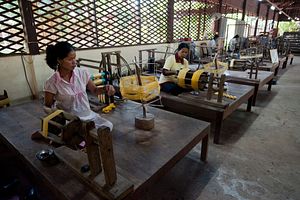During the last three years in particular, reports emerging from Cambodia’s garment factories have cast the industry in a disturbing light. The image of young women toiling for hours in dark, sweltering conditions for companies apparently averse to the diversion of even the smallest slice of their profits towards safety measures that could save the lives of their employees is a powerful one, and has placed great pressure on the Cambodian government to act in pursuit of an acceptable minimum wage.
What such reports invariably underplay, however, is the far more intractable reality that starts just meters away, beyond the factory walls. Impressive though the figures on the Cambodian garment industry are – 400, 000 garment workers from a total population of around 15,000,000 is an oft quoted statistic – they tell only a fraction of the story of migration in Cambodia. This “gentle land,” characterized as docile and unchanging by visitors from ancient Chinese merchants to their 21st century descendants is now, more than ever, churning with the movement of labor.
According to a forthcoming IDRC funded research project, even those migrant enclaves, such as Teuk Thla in the West of Phnom Penh, built in the shadow of a dozen or more garment factories, comprise only around two thirds garment workers, with a litany of other occupations completing the occupational profile. Elsewhere, amongst the half-built skyscrapers of the construction boom, or the silage tanks that filter Phnom Penh’s award-winning water supply, the numbers would be expected to be much higher. Almost none of these workers enjoy the security, safety or level of pay received by those who toil in the factories.
Their alternatives are rarely as salubrious, from the sun baked, back breaking, toil of construction work, where cheap cement torments the skin and scars the lungs, to a place amongst the army of garbage workers who crisscross Phnom Penh’s streets at night. For these latter workers, the daily tasks of collection, transportation and sorting are compounded by the shame of a very public engagement with the city’s waste. As a garbage depot owner himself admitted: “Of all the migrant jobs, this is by far the lowliest. When people come to work here I warn them that they will heavily looked down upon but that they must not let this stigma coerce them into anti-social acts such as stealing or it will make things even worse for the others.”
For anyone working and living under such conditions to proclaim themselves “lucky,” as the vast majority of migrant workers do, tends to strike a dissonant note to Western ears, resolvable only as the indomitable spirit of mankind, unbowed by circumstance. Such words, though, are not expressions of soulful bravery, but statements of numerical fact. They are the lucky ones, as for many times more Cambodians, who lack the connections or money to move, modern sector migrant labor remains an inaccessible cornucopia, far removed from their own, increasingly barren, fields.
Since the turn of the millennium, the Kingdom has suffered at least five of its worst recorded nationwide droughts or floods, alternating with cruel regularity and catastrophic disruption to livelihoods. With record surpassing record in terms of economic damage and popular displacement, evidence is mounting that these extreme events are rooted in the irreversible process of climate change.
And yet, even in the throes of this environmental crisis, poverty figures have plummeted during the past two decades. The government, perhaps enchanted more by the myth of Ankorean fertility then the contemporary reality thereof, attributes this to the rising price of rice during the period, expediently setting aside the detail that many of the poorest Cambodians are in fact net consumers of the staple. As a senior source at the Asian Development Bank’s Cambodia mission attests, these forgotten poor have been left with only one solution: “People end up to their eyeballs in debt, taking out more and more loans to survive climate shocks… People are smoothing their consumption with debt.”
Once the preserve only of individual moneylenders, the rise of microcredit has seen the accessibility of debt skyrocket during the past two decades, with recent research from Kandal province indicating that debt as a percentage of annual income has now risen above sixty percent in some rural areas. There and elsewhere, as rural roads have been expanded and improved, brightly colored, air conditioned offices have sprouted alongside them, offering easy money with minimal collateral. For those as yet insufficiently tempted, young men in crisp white shirts ride their brand new company scooters through the villages, collecting repayments and advertising loans. On any given day, debt is rarely more than a whistle and a wave away.
Of course, those unable to survive on their rural incomes without debt are inevitably unable to settle their loans by those same means. Once repayments can no longer be made, the only remaining option is to send whoever is able to the city, with or without guidance, with or without knowledge of a job. If such last-ditch strategic migrations fail, as they frequently do, the consequences for the household are ruinous. All Cambodian villages have their stories of the families who staked and lost their last chip on the city.
However, as long as Cambodians continue, in common with so many of their counterparts elsewhere in the Global South, to be propelled by the untrammelled effects of climate change towards the twin cogs of debt and exploitative labor, they will have no choice but to take such gambles and, if they succeed, gratefully accept whatever terms they are offered. “We are lucky” they will continue to say and at home their elders will agree, albeit in greater recognition of the Faustian flavor of the bargain. They will sigh, as one such village headman did recently, that “if the factories close, this village will die.”
Laurie Parsons is a doctoral candidate studying Cambodian labor migration at King’s College London.

































